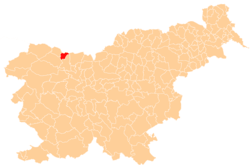Municipality of Žirovnica
The Municipality of Žirovnica (pronounced [ʒiˈɾoːu̯nitsa]; Slovene: Občina Žirovnica) is a municipality in Slovenia. The seat of the municipality is the village of Breznica.
Municipality of Žirovnica Občina Žirovnica | |
|---|---|
 | |
 Coat of arms | |
 Location of the Municipality of Žirovnica in Slovenia | |
| Coordinates: 46°24′N 14°08′E | |
| Country | |
| Government | |
| • Mayor | Leopold Pogačar |
| Area | |
| • Total | 42.6 km2 (16.4 sq mi) |
| Population (2002)[1] | |
| • Total | 4,071 |
| • Density | 96/km2 (250/sq mi) |
| Time zone | UTC+01 (CET) |
| • Summer (DST) | UTC+02 (CEST) |
| Website | www |
In the Završnica Valley, behind the Reber range that overlooks the villages, the first public hydroelectric plant in Slovenia was built in 1914. In 1952, after building a 60 m dam (the highest dam in Slovenia to date) in the Kavčke Gorge, a second hydroelectric plant opened in nearby Moste. This was the first hydroelectric plant to operate on the Sava River.
Geography
It is located in the traditional Upper Carniola region, on the southern slope of the Karawanks mountain range, along the border with Austria. The municipality borders the municipalities of Jesenice to the west, Bled and Radovljica to the south, and Tržič to the east.
Settlements
In addition to the municipal seat of Breznica, the municipality also includes the following settlements:
Notable people
A number of figures important to Slovenes come from the Municipality of Žirovnica: the poet France Prešeren, the linguist Matija Čop, Archbishop Anton Vovk, the pioneering bee-keeper Anton Janša, and the writers Janez Jalen and Fran Saleški Finžgar. Bronze busts of all five have been put up in front of the school in Zabreznica. There is a well-marked trail through the villages called The Cultural Heritage Route. This can be followed to visit certain monuments associated with the above figures (e.g., the houses where Prešeren, Čop, Finžgar, and Jalen were born, all of which are small museums, Janša's beehive) and a number of other historical and cultural monuments in the area.
External links

- Municipality of Žirovnica website (in Slovene)
- Municipality of Žirovnica on Geopedia